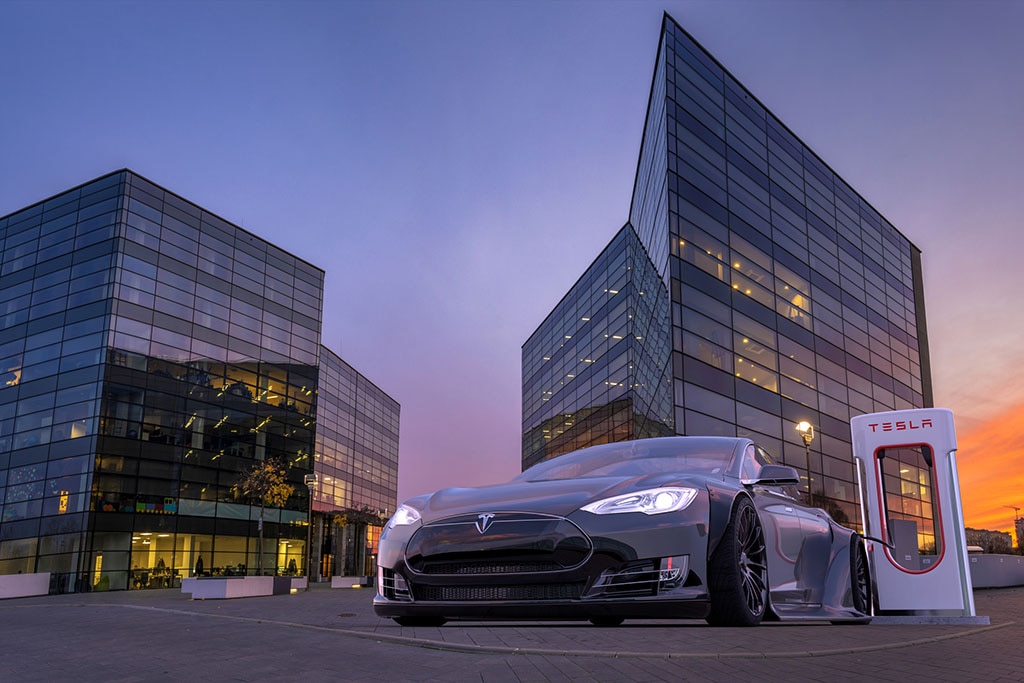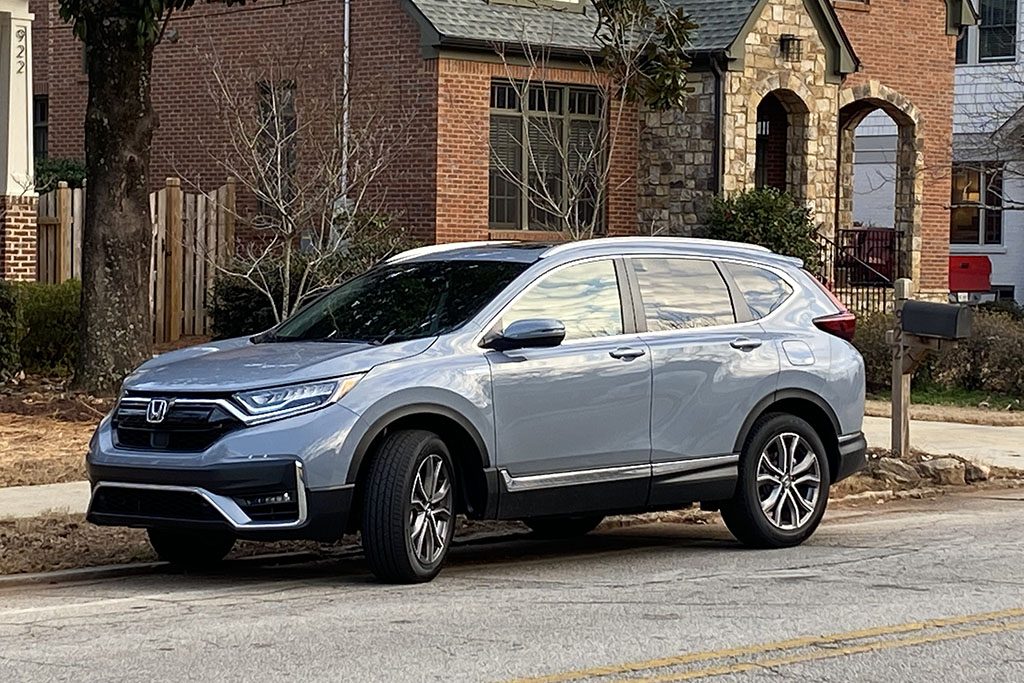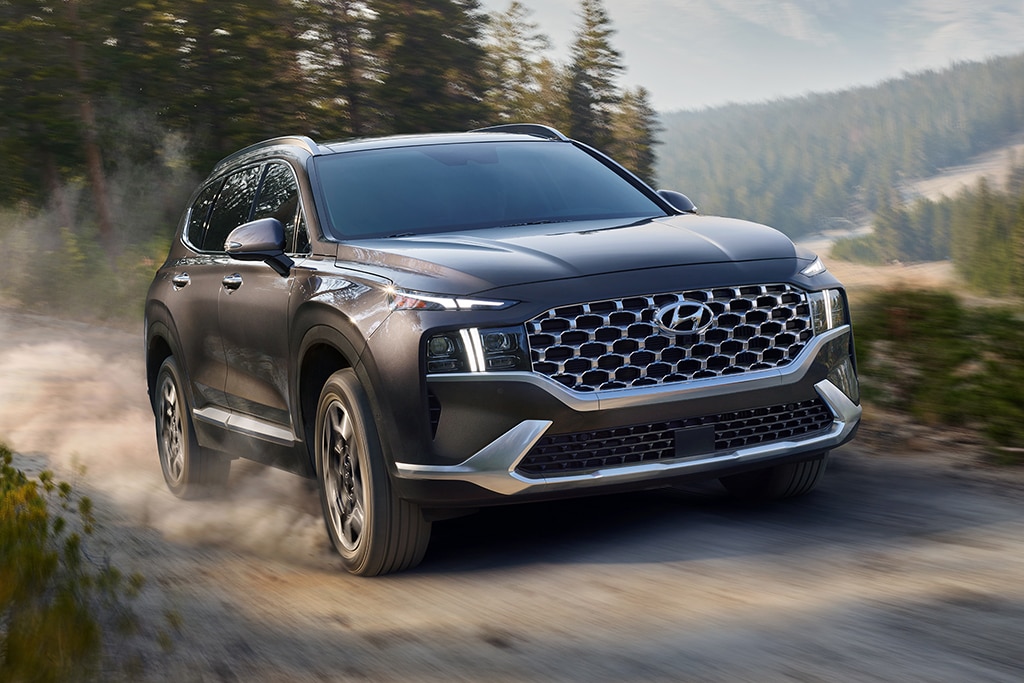There are three types of electrified vehicles: hybrid cars, plug-in hybrid cars, and electric cars. And, the future is definitely in electric cars.
But there is a lot more to electrification than simply plugging a car into a wall and expecting to go for a long drive. These three types of cars offer distinctly different types of transportation. What suits one driver’s needs almost certainly won’t work for everyone.
Here is a look at what separates electrified vehicles from one another, some examples, and a guide that might help you figure out what will work best for your driving.
Ultimately, which is better for you depends on how you plan to use it.
What Is an Electric Car or EV?
An electric car is a vehicle that uses no gasoline or diesel for its engine. Open its hood, and you’ll find plenty of wires and boxes but nowhere to add oil. Walk around to the back, and you won’t find a tailpipe sticking out beneath the bumper.
An electric car offers what we consider tailpipe emissions-free driving. The electric motor is fueled — figuratively, of course — by a large battery pack, not unlike a much more powerful version of what keeps your cell phone charged up. Like your phone, this battery pack needs regular charging, though just how often depends on its capacity.
RELATED STORIES: Electric Cars – Benefits and Disadvantages
Driving Range
Electric cars drive limited ranges on a full battery charge. Right now, the longest-distance electric car, a version of the Tesla Model 3, is estimated to go just over 400 miles in ideal use. Less expensive electric cars like the Chevy Bolt EV and Nissan Leaf get rated at around 250 miles.
Big caveat: that electric range will vary considerably by how the car gets driven. High-speed or hilly driving uses up more electric charge, just as keeping the air conditioning system at full blast. Think of the battery like that on your phone: a bright screen and plenty of app use will suck down more charge.
Charging Electric Cars
Electric cars take a while to charge, especially when they are nearly empty. Three types of electric chargers are commonly available. The least-effective — best for emergency use — is a household-style outlet, which can take over a day to fill up a nearly-depleted electric car.
Nearly all of the electric car drivers elect instead to install a Level 2 charger, which has a plug like that used in an electric clothes dryer. These cost a few hundred dollars, plus they require an electrician in many cases.
Level 2 chargers cut charging times considerably, and most drivers will plug their electric cars in overnight. Level 2 chargers are also commonly available in public spaces such as shopping centers and grocery stores for quick top-offs. These chargers tend to be more expensive than the utility bill bump you might see at home.
A Level 3 fast charger, however, supplies a tremendous amount of power to an electric car. Newer electric cars can be charged from relatively empty to around 80 percent in as little as 20 or 30 minutes on a Level 3 charger, though these facilities are few and far between in most areas. Tesla has a network of its own Level 3 chargers, though they are not compatible with other electric cars.
When Does an Electric Car Make Sense?
Most drivers will be just fine with a typical electric vehicle as long as they have somewhere to conveniently plug it in, such as a garage, driveway, or workplace. If your car parks on the street in front of your house or apartment, and your workplace has no charging stations, an electric car may prove highly impractical.
An electric car offers a limited range of inconvenient recharging, meaning one is not a good choice for a driver who regularly needs to travel long distances. If you’re a spontaneous trip planner, you may find yourself renting a gasoline car quite often.
One more benefit to an electric car is the relative lack of maintenance. Electric motors don’t require oil changes, and these cars don’t have a transmission that needs servicing. Additionally, many dual-motor electric cars such as Tesla’s vehicles are 4-wheel drive, making them suitable for wintry climates.
Electric cars seem eco-friendly, though they come with two big asterisks: for one, the electricity produced to charge them is likely to come from coal power. And for another, the mining required to extract materials that make up their batteries is far from green.
EV Pros
- Saves money: Your bottom-line will thank you. Electricity costs less than gas.
- Convenient for short trips: Tailpipe emissions-free driving around town and for shorter road trips
- Good for the environment: No more gas. Electric cars produce no tailpipe emissions.
- Low maintenance: Save money on service. Electric cars don’t need much maintenance.
- Suitable for hazardous driving: Some electric cars are even 4-wheel drive.
- Special driving lanes: Some cities offer special driving lanes, which save time.
- Incentives: Check for federal, state, and local incentives/rebates for electric cars. While GM and Tesla federal tax credits phased out, others remain.
EV Cons
- Batteries are not very eco-friendly: Electric car batteries are composed of rare earth materials that require rather dirty mining to excavate.
- Charging infrastructure: You’ll want to add a Level 2 charger at home, and no charge is rapid.
- Impractical for street parkers: If you are not able to park near a charger at night, you are missing out on ideal charging times
- Limited range: Cross-country road trips take serious planning.
- Expensive to replace battery packs: When batteries die, it can be costly to replace them.
- Peak charging costs more: A full charge during peak hours can cost drivers more money.
RELATED STORIES: 5 Mistakes to Avoid When Buying an Electric Car
What Is a Hybrid Car?
A hybrid car is a vehicle that uses a gasoline engine and an electric motor to use far less fuel while still providing good acceleration. The electric motor primarily serves to assist the gasoline engine — though technically, some cars work oppositely.
You might think of the electric motor as a booster; when it’s feeding power to the wheels, the gas engine doesn’t have to work as hard, and thus, it doesn’t use as much fuel.
Hybrids typically run on electricity alone at lower speeds, which means nothing is coming out of the car’s exhaust pipe until the gas engine kicks on when needed for higher rates of speed or more acceleration.
Batteries get charged during braking and coasting thanks to systems that capture the energy that would otherwise be wasted and convert them into charge.
Hybrids are relatively complex than conventional gas cars, though perhaps not by as much as you expect. For one, their gas engines are generally smaller and less complex since the electric motor does a lot of the heavy lifting. Additionally, the electric motor itself requires virtually no maintenance.
Like an electric car, a hybrid car battery pack will eventually begin to degrade. Replacements are expensive, but these batteries take many years to wear out. Manufacturers designed newer hybrid cars with battery packs tucked away as unobtrusively as possible, though a hybrid version of a gas-only car will often have a slightly smaller trunk.
A hybrid is a natural stepping stone from gasoline to electricity. Many drivers pick hybrids for their ease of use; they require gasoline fill-ups (though not as often as a gas-only car), and because of that, they have an essentially limitless range punctuated by brief gas station visits.
Nearly every automaker now offers a hybrid car, ranging from the Toyota Prius to the Ford F-150 Hybrid pickup. A wide variety of vans, crossovers, SUVs, sedans and even some convertibles now offer at least some degree of electrification.
Hybrid Pros
- Lower initial cost than electric cars: Hybrid vehicles are less expensive than similar electric and plug-in hybrids
- Big fuel economy gains: Most hybrids are far more fuel-efficient than gas cars.
- Lots of choices: Hybrid vehicles come in all shapes and sizes.
- No need to charge: Hybrids can drive anywhere.
- No compromise cargo-carrying: Relatively small battery packs mean plenty of trunk space.
Hybrid Cons
- Lots of complexity: Hybrids pair both gas and electric motors, which means the potential of more to go wrong.
- Limited emissions-free driving: Any time the gas engine is running, tailpipe emissions are occurring.
- Not the greenest option available: While still more eco-friendly than a gas car, hybrids do still pollute.
- Still more expensive than gas cars: Most automakers charge a premium for hybrids over conventional gas models.
What Is a Plug-in Hybrid Car or PHEV?
A plug-in hybrid, also known as a PHEV, or plug-in hybrid electric vehicle, features a larger battery pack than a conventional hybrid, allowing for short-distance drives using electric power only. Essentially, take everything you’ve learned above about electric and hybrid cars, and combine them.
Most newer hybrids that plug in can achieve 25 or so miles on electric power alone. After that, they behave like a conventional hybrid. Longer-range plug-in hybrids will be coming as technological development works toward more power-dense batteries that don’t take up too much space.
Charging PHEVs and the Fuel Tank
Many newer plug-in hybrids allow the driver to “bank” electric charge to use it when they see fit, such as at lower speeds where they may be able to get more miles out of the charge than at highway speeds where the charge will deplete faster.
Plug-in hybrids don’t take too long to charge. Even someone with a 20-mile one-way commute and a place to charge at work could use no gasoline. That said, plug-in hybrid’s gas engine will cycle on occasionally to ensure that the fuel in the tank doesn’t go bad.
Hybrids with plugs can add a little charge in certain driving, such as heavy braking or long-distance downhill coasting. But it would take a daily commute down a mountain like Pikes Peak in Colorado to make a notable self-charging impact.
A hybrid that plugs in is an ideal all-rounder for many drivers because it pairs the allure of tailpipe emissions-free driving with the comfort of go-anywhere range provided by the gas engine.
PHEV Pros
- Emissions-free commuting for many: With a range of around 25 miles for many PHEVs, some drivers can commute without emissions.
- Quick charging: Smaller battery packs than purely electric cars mean fairly quick charges
- Limitless range: Even after the electric battery is depleted, a PHEV can drive anywhere on gasoline.
- Great fuel economy: PHEVs don’t use much gas in most driving.
- Most people won’t know you’re in a hybrid: PHEVs look like normal cars.
PHEV Cons
- Limited electric range: Around 25 miles of electric range still isn’t much.
- Extra complexity: PHEVs are even more complicated than hybrids.
- Not many choices: Only a handful of PHEV models are on the market.
- Smaller trunks: In most cases, PHEVs have larger batteries than hybrids.
- Definitely a stepping stone: Plug-in hybrids are widely viewed as a step in the electric cars’ direction, not a long-term solution.
What Are Hydrogen Fuel-Cell Cars?
You may have heard of hydrogen fuel-cell cars available on a limited trial basis, primarily in California. The fuel-cell cars get widely pitched as the most eco-conscious vehicles. These vehicles add tanks of hydrogen to the mix to power the electric motor, which means lighter and smaller batteries.
Unlike electric cars, hydrogen fuel-cell vehicles require only a brief top-off with compressed hydrogen, the most common element on the planet. It takes about as much time to fill one up as it does a gas car.
Hydrogen is safe — it carries less energy than gasoline — but there is minimal infrastructure open to the public outside California to fill a vehicle up with hydrogen.













I’ve driven a PHEV, a Honda Clarity, for 5 years. When I bought it, the following was explained to me: The Clarity never runs purely on gas. When the car is placed in the HV Charge mode, the gas engine becomes a generator that recharges the E battery. In this car, I can drive up to 60 miles in EV, depending upon conditions, like keeping my speed to 55 mph, and not having to use the heater, a/c, wipers, or ither auxiliaries. For half if the year I’ve charged my car during the day as I have solar panels. For the other half of the year I home charge at Level 1. It used to be that most PHEVs can run about 25 +\- miles on E alone, but there are a few now that state their range as being 35-45 miles. It is very unfortunate that Honda did not adequately market the PHEV Clarity, for it is the best car I’ve ever driven. I do long distance roadtrips twice a year and have never had a problem, and my maintenance is next to nothing.
Thanks for reading, Nona. You aren’t the only praising the Clarity. Many Clarity fans blame poor marketing on its relatively short life.